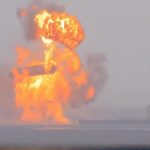NASA has announced the landing site for its robotic lunar rover which is planned to reach the moon in 2023.
The VIPER (Volatiles Investigating Polar Exploration Rover) will land near the Nobile Crater at the moon’s south pole where it will explore and map both the surface and the subsurface to identify water and other resources
It is part of the space agency’s Artemis programme, named after the mythological sister of Apollo, the first moon mission’s namesake, which aims to take the first woman and the next man to the lunar surface by 2024 – although that date is now in question.
In 2018 a team of scientists confirmed that water ice exists on the moon in the darkest and coldest parts of its poles.
Five years on from that confirmation, VIPER will launch on a SpaceX Falcon Heavy before reaching the surface – one of the coldest areas in our solar system – using the Griffin lander developed by another private company called Astrobotic.
It will land near the Nobile Crater which was formed when the moon collided with another smaller celestial body. As the crater is almost permanently covered in shadows, ice is able to exist there.
“Once on the lunar surface, VIPER will provide ground truth measurements for the presence of water and other resources at the moon’s south pole,” said Thomas Zurbuchen, associate administrator for science at NASA.
SpaceX Inspiration4 mission: Who are the civilian astronauts, what are their roles and how will they land?
NASA says rock samples found by rover reveal alien life may have existed on Mars
NASA’s Perseverance rover successfully drills first rock for sample
“The data VIPER returns will provide lunar scientists around the world with further insight into our moon’s cosmic origin, evolution, and history, and it will also help inform future Artemis missions to the moon.”
“Selecting a landing site for VIPER is an exciting and important decision for all of us,” said Daniel Andrews, VIPER project manager.
“Years of study have gone into evaluating the polar region VIPER will explore. VIPER is going into uncharted territory informed by science to test hypotheses and reveal critical information for future human space exploration,” he added.






















